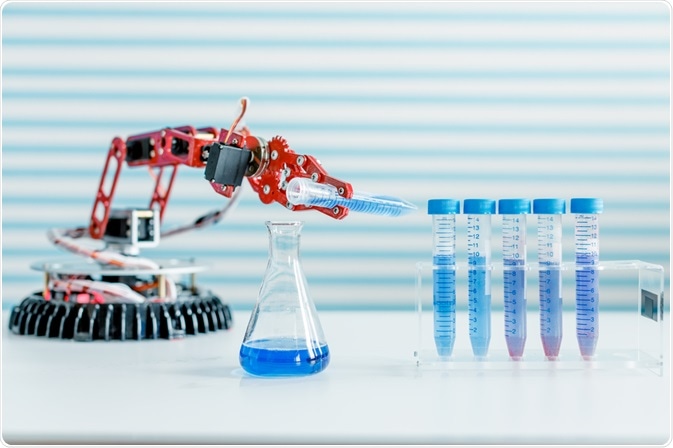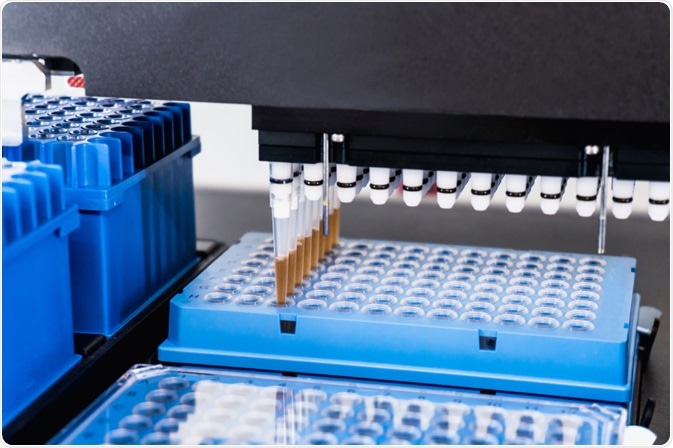As technological capabilities increase, so do the opportunities for automating laboratory processes. Nowadays, automated equipment is becoming a staple part of the lab. But what exactly do we mean by lab automation? And how is it lending a hand in advancing research?

Image Credit: luchschenF/Shutterstock.com
What is lab automation?
Lab automation is the use of instrumentation to perform laboratory processes, requiring minimal human input. Automation can be used anywhere from a single step of an experimental process, all the way through to the entire workflow.
The product range available is now vast, making use of robotics, computers, and software.
Lab automation can be split into the pre-analytic, analytical, or post-analytical stages. Although, automated processes can integrate across the board, applying to all parts of the experimental process.
But before looking at the types of automated systems available, it is worth considering the reasons why they are so sought after.
Why do we need lab automation?
Automating laboratory tasks improves the overall efficiency of experimental processes by speeding up tasks, cutting waste, using lower quantities of reagents, and allowing for higher throughput of experiments. Combined, this higher efficiency leads to lower running costs of the laboratory.
Using automated systems in the lab saves researchers from performing time-consuming and repetitive tasks, freeing them up to carry out more specialized processes. Automation also aims to increase data reliability and accuracy, as error and variability can occur at all stages of the experimental process.
Furthermore, automated technology can improve laboratory safety by using automated systems to handle, and correctly store, harmful substances. Consequently, laboratory personnel is more protected from the exposure of these harmful reagents and processes.
Pre-analytical automation
Pre-analytical refers to any of the steps from sample/reagent storage up to preparation and addition. Error at the pre-analytical stage has been reported at up to 70%, occurring from factors such as mislabeling, poor storage, and incorrect volumes.
Consequently, automating repetitive tasks at the pre-analytical steps offers a huge impact on the accuracy and reliability of results.
Using a combination of robotics, sensors, and software, automated systems are now available to perform many pre-analytical tasks, from storing and labeling, to transporting and centrifuging, ready for sample transferal into the analytical phase.

Image Credit: Elpisterra/Shutterstock.com
Analytical automation
The early forms of lab automation were involved in the analytical stages of experimental processes. The first automated analyzer was produced in 1957, called the AutoAnalyzer, which used continuous flow analysis.
The AutoAnalyzer improved the number of samples that could be tested each hour (150), pioneering high-throughput technologies.
The development of the electronic acquisition of data measurements, such as laboratory information systems (LIS)/laboratory information management systems (LIMS), also opened up the automated laboratory revolution.
The software controls and integrates automated sample analysis instrumentation, as well as electronically collects and stores laboratory data measurements, which can then go under analyses.
As LIMS has become further integrated with different software and equipment, its capabilities have grown, such as its use in sequencing.
Post-analytical automation
The final parts of the experimental process involve data analysis and interpretation, sample management, and reporting. Automated equipment has been designed to archive tested samples after testing, reducing errors from mislabeling or incorrect storage. If needed for further analysis, samples are also readily retrieved from the archive.
Total lab automation
Automating all pre-analytical, analytical, and post-analytical stages result in total lab automation — subtotal automation is when only two out of the three phases are automated.
Simpler, cheaper automation exists by automating each phase separately (called stand-alone automation), where transportation of samples between each phase is needed.
In 1984, a primitive form of total lab automation was shown possible by Dr. Masahide Sasaki. Today, total lab automation is a viable option but is still costly to set-up and maintain.
However, depending on the application, the overall cost may be reduced in the long-term, due to high efficiency, reduced waste, and high throughput from automated systems.
Conclusions
Lab automation aims to provide lower overall costs, higher throughput, more efficient testing, a safer environment, reduced experimental error, and improved accuracy and reliability of the data.
However, automation remains a costly process and should be tailored separately to each lab, depending on their experimental needs and workloads.
What does the future of lab automation look like?
References
- Armbruster, D. A., Overcash, D. R. and Reyes, J. (2014) ‘Clinical chemistry laboratory automation in the 21st Century - Amat Victoria Curam (Victory loves careful preparation)’, The Clinical Biochemist Reviews, 35(3), pp. 143–53.
- Da Rin, G. (2009) ‘Pre-analytical workstations: A tool for reducing laboratory errors’, Clinica Chimica Acta, 404(1), pp. 68–74.
- Ebubekir, B., Nurinnisa, O., and Nurcan, K.-B. (2017) ‘Automation in the clinical laboratory: integration of several analytical and interlaboratory pre- and post-analytical systems’, Turkish Journal of Biochemistry, 42(1), pp. 1–13.
- Forest, J. C., Rheault, C. and Dang-Vu, T. K. (1985) ‘The Laboratory Information System (LIS): I-Application to the clinical chemistry laboratory’, Clinical Biochemistry, 18(2), pp. 78–84.
- Hawker, C. D. (2017) ‘Nonanalytic laboratory automation: A quarter-century of progress’, Clinical Chemistry, 63(6), pp. 1074–1082.
- Hawkins, R. (2012) ‘Managing the pre- and post-analytical phases of the total testing process’, Annals of Laboratory Medicine, pp. 5–16.
- Lippi, G. and Da Rin, G. (2019) ‘Advantages and limitations of total laboratory automation: A personal overview’, Clinical Chemistry and Laboratory Medicine, 57(6), pp. 802–811.
- Plebani, M. et al. (2014) ‘Quality indicators to detect pre-analytical errors in laboratory testing’, Clinica Chimica Acta, 432(3), pp. 44–48.
- Sasaki, M. (1984) ‘Completed automatic clinical laboratory system by sample transportation. The beltline system’, Rinsho byori. The Japanese Journal of Clinical Pathology, 32(2), pp. 119–126.
- Scholtalbers, J. et al. (2013) ‘Galaxy LIMS for next-generation sequencing’, Bioinformatics, 29(9), pp. 1233–1234.
- SKEGGS, L. T. (1957) ‘An automatic method for colorimetric analysis’, American Journal of Clinical Pathology, 28(3), pp. 311–322.
Further Reading
Last Updated: Sep 11, 2020